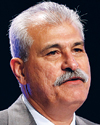Officials at the nation’s largest drinking-water association called for a new mechanism to fund water infrastructure that is generating buzz on Capitol Hill: a national infrastructure bank. Meeting for their yearly conference June 14-18 in San Diego, American Water Works Association officials announced they would work with lawmakers in Washington, D.C., to push for legislation that would establish a bank to support water infrastructure projects.
The current credit crunch has made it “hard for communities to access capital for critical infrastructure projects,” despite the infusion of funds from the American Recovery and Reinvestment Act, said Michael Leonard, AWWA’s 2008-2009 president and water operations manager for the city of Roswell, Ga. He said federal stimulus money “just didn’t make much of a dent” in propelling water infrastructure projects and called a federal infrastructure bank “a smart, commonsense solution [that strikes] just the right balance between federal assistance and local responsibility.”

According to the latest survey released in March by the U.S. Environmental Protection Agency, the nation’s total water infrastructure need is nearly $335 billion through 2026.
The infrastructure bank would provide direct financing through loans or loan guarantees for larger projects at interest rates at or below the U.S. Treasury bond rate. It could also purchase or guarantee state revolving fund bonds, which would lower their interest rates and increase loans and subsidies to communities.
The idea of a national infrastructure bank is gaining support in Washington. During the last session of Congress, a Senate bill sponsored by Sen. Christopher Dodd (D-Conn.), chairman of the Banking Committee, received some support. President Barack Obama also has requested funds for a national infrastructure bank in his fiscal 2010 budget.
In the House, Rep. Rosa DeLauro (D-Conn.) introduced a bill this year that would create an infrastructure bank for water projects, as well as for roads, bridges and electrical grid projects. That bill has garnered a fair amount of support from industry groups, including the American Society of Civil Engineers and the AFL-CIO’s Building and Construction Trades Dept.
Tommy Holmes, AWWA’s legislative director, said the organization is working with Dodd and his staff to push for a comparable bill that would include more provisions specifically related to water infrastructure.
Peter Silva, who has served on California’s Water Resources Control Board since 2000 and is President Obama’s nominee to head up EPA’s Office of Water, said although stimulus funding will help fund critical infrastructure projects, he supported the AWWA infrastructure bank proposal.
Other alternative funding mechanisms for water infrastructure projects discussed included public-private partnerships and full-cost pricing for ratepayers. Financing and funding issues top the list of utilities’ concerns this year in AWWA’s annual state-of-the-industry survey, according to Craig Woolard, incoming association president and director of the Anchorage Water and Wastewater Utility. “A critical need for utilities is access to capital,” he said. “The need is so much bigger than the amount of funds that they have.”
Climate change also continued to be a hot topic at the AWWA gathering. Peter Gleick, president and co-founder of the Pacific Institute for Studies in Development, Environment and Security in Oakland, Calif., warned attendees that engineers should now be designing infrastructure with the anticipated effects of climate change in mind. “If we build it for yesterday’s climate, [we’ll] bear the consequences in 10 or so years,” he said. “The cost of doing nothing is likely to be far, far greater...than [addressing] it now.”
For the city of San Diego, which has been experiencing a multiyear drought, water officials acknowledge some of the effects of climate change may already be manifesting. Jim Barrett, director of public utilities for the city of San Diego, told AWWA attendees the city is considering a variety of options to find new sources of drinkable water, including mandatory conservation, water reclamation and desalination. “Desal may be our only hope,” he said. “As the price of water continues to rise, it’s hard to deny that it is an option in San Diego.”
Dan McCarthy, president and CEO of the global water business for Overland Park, Kan.-based Black & Veatch, noted the is seeing more clients interested in climate change. “It’s a real issue. We still have debate over whether it’s really climate change or just a longer climate cycle, but to facility managers it really doesn’t matter,” he told the conference. “They have to deal with a reality that is different than what was forecast.”


Post a comment to this article
Report Abusive Comment